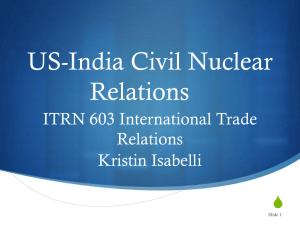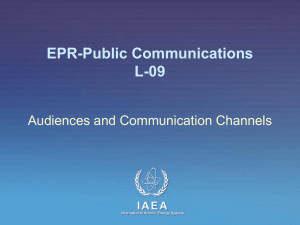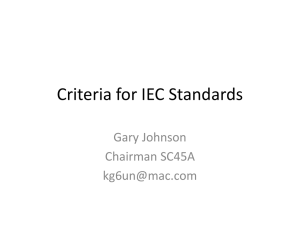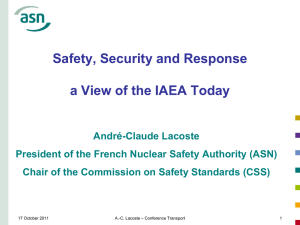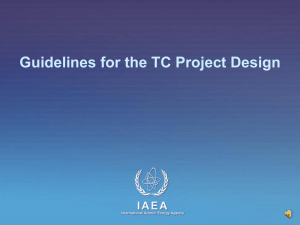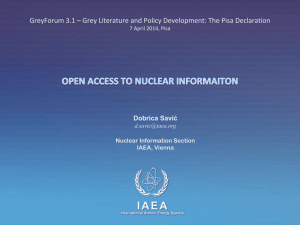Mrabit - International Atomic Energy Agency
advertisement
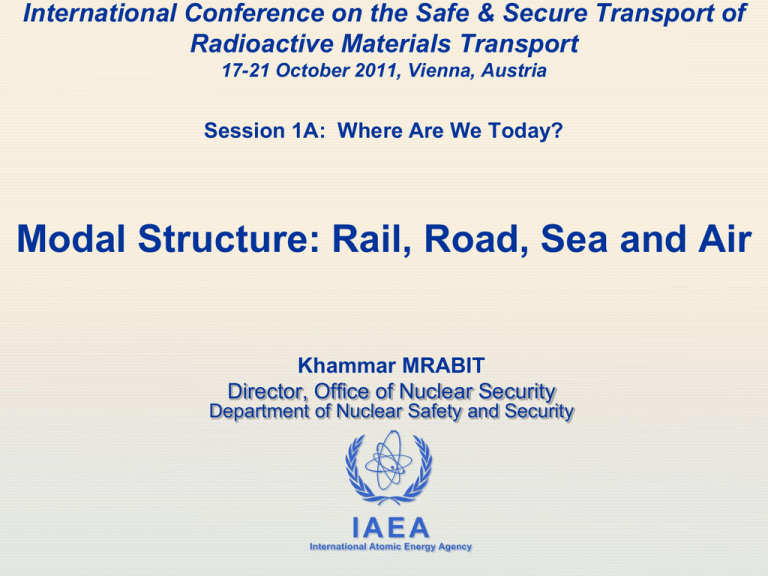
International Conference on the Safe & Secure Transport of Radioactive Materials Transport 17-21 October 2011, Vienna, Austria Session 1A: Where Are We Today? Modal Structure: Rail, Road, Sea and Air Khammar MRABIT Director, Office of Nuclear Security Department of Nuclear Safety and Security IAEA International Atomic Energy Agency Background • Transport: very complex issue requiring harmonization • Problems were increasingly being encountered at • • • • seaports, airports and rail yards where dangerous goods were trans-shipped International transport has to deal with at least (if transshipment) 2 regulatory systems (instruments) Several modes of transport (with dedicated regulations) Responsibility is with the consignor (for safety) when it is within the State (each) for security Large array of Stakeholders (customs, regulatory bodies, operators, shippers for all modes, …) IAEA 2 Background (Cont’d) • Transport: very complex issue requiring harmonization • Nuclear security of transport of nuclear material to prevent the unauthorized removal of such material and to prevent theft and sabotage leading to potential unacceptable radiological consequences • Specific Transport regulations for safety and for security issues, for nuclear and for other radioactive material, for each mode of transport • How has the international community organized itself to face this complexity and the challenge of harmonization? IAEA 3 General Scheme Level 1 (Global) Level 2 (Global) Level 3 Level 4 (Global / Regional) (National) Safety issues Radioactive Material Transport Requirements Dangerous Goods Transport Requirements RAM National DG Transport Provisions Provisions Security issues NM Modal Transport Modal Provisions Transport Modal Provisions Transport Modal DG Provisions Transport Nuclear Material Transport Recommendations IAEA Convention National NM Transport Provisions 4 Level 1: Class 7 transport – Safety issues • Legitimacy of the IAEA • IAEA Statute (III.A.6:establish or adopt safety standards) • Entrusted by ECOSOC • TS-R-1 “IAEA Regulations for the Safe Transport of Radioactive Material” • Elaborated by IAEA and MSs and approved by BoG • Incorporated in UN Model Regulations (completely since 1999) • 6 guides (TS-G-1.X) complete TS-R-1 (2005 & 2009 edition) • Transport principles • Prevent accidents to persons or property and damage to the environment • Make transport feasible by reducing risks to a minimum IAEA 5 Level 1: Class 7 transport – Security issues • Legitimacy and Role of the IAEA • IAEA Statute (Articles II, III.A.6 and XII), • BoG and GC resolutions (Nuclear Security Plans), • Security Council resolutions 1373 (2001) and 1540 (2004) Facilitate adherence to and implementation of the legal framework • Transport of Nuclear Material Convention on the Physical Protection of Nuclear Material (1980) • Binding instrument (1987) for international transport • Scope: physical protection of NM used for peaceful purposes • Considering Theft and Unauthorized Removal for building IND • Deal with criminalization of certain offences and international cooperation IAEA 6 Level 1: Class 7 transport – Security issues (cont’d) • Transport of Nuclear Material 2005 Amendment to CPPNM • Extension to nuclear facilities and to domestic transport • Expanded cooperation between and among States • rapid measures to locate and recover stolen or smuggled nuclear material, • mitigate any radiological consequences of sabotage and • prevent and combat related offences • Considering sabotage and radiological consequences NSS-13 (INFICIRC/225, Rev.5 (2011)) • “Nuclear Security Recommendations on Physical Protection on Nuclear Material” - For international and national transport • To achieve effective physical protection against the theft or unauthorized removal of nuclear material and against the sabotage by individuals or groups IAEA 7 Level 1: Class 7 transport – Security issues (cont’d) • Transport of Other Radioactive Material NSS-14 (2011) • “Nuclear Security Recommendations on Radioactive Material” • Complementary to NSS-13 • Related to Code of Conduct for Safety and Security of Radioactive Sources • Two related implementing guides: • NSS-09 with definition of security levels (basic and enhanced) and high consequence radioactive material (with dedicated security plans) and • NSS-11 (Radioactive Sources, 2009) IAEA 8 Level 1: Class 7 transport Safety/Security issues Three sets of Requirements/Recommendations: • Safety - TS-R-1; • Security of Nuclear Material (NSS-13); and • Security of other Radioactive Material (NSS-14) Challenges: • Consistency between sets of Requirements and Recommendations • Harmonization IAEA 9 Level 2: All Classes transport • ECOSOC as integrator • Legitimacy of SCETDG (ECOSOC Resol.), with UNECE Secretariat • UN Model Regulations Need for consistency • Basis for Model Regulations • TS-R-1 consistent with the framework and general principles of UN Orange Book (UNOB) Differences between UN Model Regulations and TS-R-1 • 2 sets of recommendations mainly evolving independently How should the interface IAEA-SCETDG (TS-R-1 /UNOB) work ? Consistency between Safety Requirements for Class 7 and other classes? Does it work for Security Recommendations? IAEA 10 Level 3: Modal transport of all Classes • Global Scheme – through binding instruments At global level (for air and sea transport) • Technical Instructions of ICAO through Chicago Convention • IMDG Code through SOLAS Convention At regional level (for land transport) • European Agreement concerning the International Carriage of Dangerous Goods by Road (ADR) • European Agreement for the International Carriage of Dangerous Goods on Inland Waterways (ADN) • International Carriage of Dangerous Goods by Rail (RID) through COTIF • MERCOSUR/MERCOSUL Agreement (road and rail transport) IAEA 11 Level 3: Modal transport of all Classes (Cont’d) • Sea Transport United Nations Convention on the Law of the Sea (UNCLOS) (adopted in 1982) Safety Of Life At Sea Convention (SOLAS) • SOLAS Convention 1974, entered into force on 25 May 1980 • Carriage of Dangerous Goods in packaged form (by sea) shall be in compliance the relevant provisions of the IMDG Code (Reg. 3 of Part A of Chapter VII of SOLAS Convention) International Maritime Dangerous Goods (IMDG) Code • Mandatory for the 159 contracting parties to SOLAS Convention • Amendment 34-08 includes the requirements of TS-R-1 (2005 edition) and security provisions (and the recommendations) of 15th edition of UN Model Regulations. IAEA 12 Level 3: Modal transport of all Classes (Cont’d) • Sea Transport Code for the Safe Carriage of Irradiated Nuclear Fuel, Plutonium and HighLevel Radioactive Wastes in Flasks on board Ships (INF Code) • Mandatory since 2001 through Reg. 15 in Part D of Chapter VII of SOLAS Convention • Ship carrying INF cargo complies with the INF Code requirements International Ship and Port Facility Security (ISPS) Code • Chapter XI-2 of SOLAS Convention • Security provisions, not specifically on security of dangerous goods Convention for the Suppression of Unlawful Acts against the Safety of Marine Navigation (SUA) • The 2005 Protocol to the 1988 SUA Convention expanded the scope to include provisions on nuclear material. • Adopted in October 2005, entered into force on 28 July 2010. IAEA 13 Level 3: Modal transport of all Classes • Air Transport Chicago Convention • On International Civil Aviation, Binding instrument (1947) • Annex 18 = international standards and recommended practices for the safe transport of dangerous goods by air Technical Instructions of ICAO • Mandatory for the 190 contracting parties to Chicago Convention • 2011-2012 edition of the Technical Instructions of ICAO include TSR-1 (2009 edition) and security provisions (and the recommendations) of 16th edition of UN Model Regulations Dangerous Goods Regulations of IATA • Not mandatory • In practice, airlines continue to require compliance with IATA’s current DGR (Updated every two years) IAEA 14 Level 3: Modal transport of all Classes Land Transport (for Europe, Central Asia, Middle East and North Africa) 2011 edition of ADR, RID and ADN = include TS-R-1 (2009 edition) and security provisions of 16th ed. of UNOB. ADR, RID and ADN = applicable for international transport and national transport (in EU countries) 1. Road transport (ADR) •ADR, Binding instrument (1968), under the auspices of UNECE •47 ADR contracting Parties: 2. Inland waterways transport (ADN) •ADN, Binding instrument (2008), under the auspices of UNECE •17 ADN contracting Parties in Europe 3. Rail transport (RID) •RID, Binding instrument (1980), under the auspices of OTIF •45 Contracting States to COTIF IAEA 15 Level 3: Modal transport of all Classes • Land Transport (Outside Europe, Central Asia, Middle East and North Africa) MERCOSUR/MERCOSUL Agreement of Partial Reach to Facilitate the Transport of Dangerous Goods • signed by Brazil, Argentina, Paraguay and Uruguay • regulates road and rail transport of dangerous goods, including radioactive material, between these States. • includes the requirements of ST-1 (1996 edition) and the recommendations of 12th edition of UN Model Regulations (security provisions appeared only in the 13th edition,2003). • Revised edition under preparation with the requirements of TS-R-1 (2009 edition) and the security provisions (and the recommendations) of 17th edition of UN Model Regulations. Other agreements under preparation (South America, Africa, Asia) IAEA 16 Level 4: Implementation in National Law • Regulatory framework • First responsibility of each and every State • Directly depending on the adherence to and ratification of legal instruments Large array of Conventions and agreements, in connection with: - The transport of dangerous goods - All modes of transport - Physical protection of nuclear material IAEA 17 Comprehensive Regulatory framework for Transport Safety The implementation of IAEA Regs into the Model and Modal Regulations (190) All 9 Classes All modes Class 7 All modes Air Mail (192) Sea (159) Land transport Road, Rail and Inland Waterway IAEA Regional: MERCOSUR/MERCOSUL (4) ADR (47), RID (45), ADN (17) 18 A Regulatory framework for Transport Safety and Security Class 7 Radioactive Material ? Mode specific ? All 9 Classes All modes All 9 Classes One mode All modes National Law NSS-14 (NSS-09, NSS-11) Nuclear Material All modes ? ? IAEA NSS-13 (through CPPNM) National Law 19 Transposition of Safety and Security in National Legislation and Regulations National Law SAFETY Modal Regs UNOB TS-R-1 Radioactive Material Nuclear Material CPPNM NSS-14 (NSS-09 NSS-13 NSS-11) UNOB Cat III material (with potential radiological consequences) IAEA or below Cat III Modal Regs National Law SECURITY 20 Conclusions It is crucial that: • Member States fully participate in the elaboration of Requirements/Recommendations; • Member States commit to ratify international instruments; • The Agency continues strengthening interface / synergy between safety and security, and then • The Agency, the UN and other specialized Agencies further strengthen their interface and cooperation. IAEA 21 Conclusions (Cont’d) Efforts to ensure harmonization of requirements and recommendations in transport safety and security should continue: • Among the Modes of Transport; • Among the different Classes of Hazards; • Between Safety and Security; and • Between Nuclear Material and Other Radioactive Material. IAEA 22 Thank you - Q&A IAEA 23 Level 3: Modal transport of all Classes • Postal Transport Universal Postal Union Convention • Universal Postal Convention signed in Vienna on 10 July 1964. • The Universal Postal Union (UPU) regulates the international postal services of its 192 member States • The Convention requires that the activity of the radioactive contents does not exceed 1/10 of the activity limits prescribed for excepted packages, as defined by and in compliance with IAEA Transport Safety Regulations (TS-R-1, edition 2009). IAEA 24

